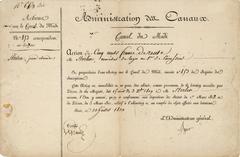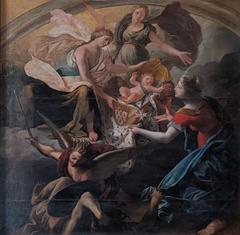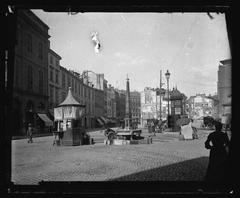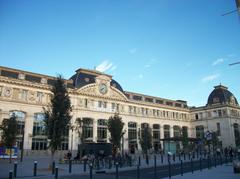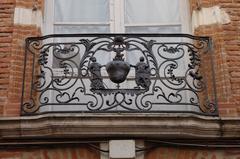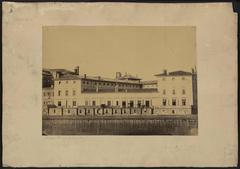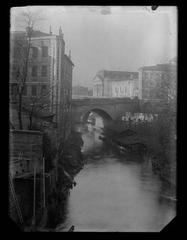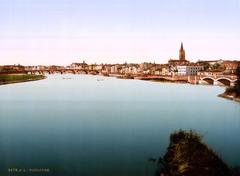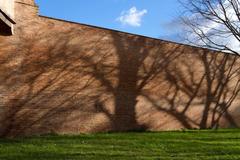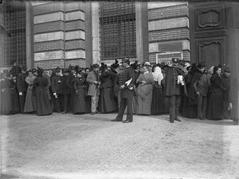Demeure Toulouse Visiting Hours, Tickets, and Historical Sites Guide
Date: 03/07/2025
Introduction: The Demeure and Its Importance in Toulouse
Toulouse is renowned as “La Ville Rose” for its signature pink brick architecture, a city where history and modern urban life blend seamlessly. Among its architectural treasures, the Demeure—located at 77 Avenue Frédéric-Estèbe and 30 Rue Marc-Arcis—serves as a testament to the city’s evolving heritage from the 18th to the early 20th century. Also known as Domaine de Caussade or SDC La Demeure de Frédéric, this residence reflects the city’s journey from noble country estates to a dynamic urban district, all while preserving the neoclassical elegance and bourgeois ambition that characterize Toulouse’s identity.
While the Demeure remains a private residence with no public access to its interiors, the protected façades, sculpted stonework, and unique oculi windows are visible from the street and offer a glimpse into the craftsmanship of their era. The surrounding Minimes district, enriched by cultural landmarks like the Basilique Saint-Sernin and Canal du Midi, makes this a rewarding stop for history lovers and urban explorers alike. This guide covers essential information about the Demeure—including accessibility, nearby attractions, photography tips, and ways to engage through guided tours or heritage events—so you can make the most of your visit to this hidden gem in Toulouse. (annuairedescoproprietes.fr, Monumentum, POP Culture, France.fr, about-france.com)
Table of Contents
- Discover the Charm of 77 Avenue Frédéric-Estèbe and 30 Rue Marc-Arcis
- Architectural Context and Urban Setting
- Heritage Status, Cultural Importance, and Community Engagement
- Summary and Visitor Tips for Demeure
- References and Further Reading
Discover the Charm of 77 Avenue Frédéric-Estèbe and 30 Rue Marc-Arcis
Origins and Architectural Context
77 Avenue Frédéric-Estèbe: The Domaine de Caussade
This address is home to the Domaine de Caussade, a prominent copropriété (condominium) of 41 lots, emblematic of Toulouse’s residential expansion during the late 19th and early 20th centuries (annuairedescoproprietes.fr). The avenue, named for local figure Frédéric Estèbe, keeps alive the tradition of honoring notable citizens through urban naming. The building’s pink brick façade—a product of local materials—reflects the city’s characteristic warmth and distinctive architectural style (Wikimedia Commons).
30 Rue Marc-Arcis: Artistic Heritage
Located in a street named for acclaimed sculptor Marc Arcis (1652–1739), this address recalls the city’s artistic legacy. Arcis, a prominent baroque artist and royal sculptor, made significant contributions to Toulouse’s artistic and cultural scene (theses.fr). The neighborhood continues this creative tradition through its architectural diversity.
Practical Visitor Information
- Visiting Hours: Both addresses are residential; there is no public interior access, but the exteriors can be viewed year-round.
- Guided Tours: Some local walking tours pass through these neighborhoods, sharing historical insights. Check with the Toulouse Tourist Office for current options.
- Accessibility: The area is well-served by metro and bus lines, with flat sidewalks and nearby parking.
- Nearby Attractions: Major sites like the Basilique Saint-Sernin, Capitole de Toulouse, and Canal du Midi (a UNESCO World Heritage Site) are within easy reach (about-france.com).
- Photography Tips: Early morning and late afternoon provide the best light for photographing the pink brick façades.
Historical Significance and Urban Development
Both addresses illustrate Toulouse’s transformation from rural outskirts to vibrant urban neighborhood, reflecting the rise of the bourgeoisie and the city’s industrial growth (annuairedescoproprietes.fr). Rue Marc-Arcis, in particular, showcases the city’s ongoing connection to its artistic roots.
Architectural Features and Preservation
The signature “brique foraine” (pink brick) is a staple of Toulouse’s identity. Preservation work ensures that renovations honor this tradition, allowing visitors to experience the original character of these historic neighborhoods.
FAQ
Q: What are the visiting hours?
A: As these are private residences, there are no specific visiting hours; you can enjoy the exterior architecture at any time.
Q: Are guided tours available?
A: While the buildings themselves are private, several walking tours include the area. Check with the Toulouse Tourist Office.
Q: What other historical sites are nearby?
A: The Basilique Saint-Sernin, Capitole de Toulouse, Couvent des Jacobins, and Canal du Midi are all close by.
Q: Is the area accessible by public transport?
A: Yes, both addresses are served by metro and bus.
.jpg)
Architectural Context and Urban Setting
The Demeure at 77 Avenue Frédéric-Estèbe / 30 Rue Marc-Arcis is a distinguished example of 18th-century residential architecture, originally set at the city’s edge and now part of its urban core. Its presence at the intersection of two key streets embodies Toulouse’s urban growth during the Enlightenment, when affluent families established country retreats (maisons de campagne) on the periphery (Monumentum). The area has evolved from the Caussade estate into a vibrant neighborhood, yet the Demeure’s historic features remain prominent.
Visitor Information: Hours, Tickets, and Accessibility
- Visiting Hours and Admission: The Demeure is privately owned, and there are no regular public visiting hours or ticketed entry. Visitors can view the exterior from the street during daylight.
- Accessibility and Travel Tips: The site is accessible via public transportation, with nearby bus and metro stops (Moovit). The neighborhood is flat and pedestrian-friendly.
Structural Composition and Materials
- Façades and Elevations: The protected façades, composed of finely molded pink brick and sculpted stone, are characteristic of Toulouse’s famous “Pink City” look (POP Culture, e-a-a.com).
- Windows and Oculi: Circular oculi windows and traditional lintels, echoing those of other elite residences, are key features. Some modifications have occurred over time, but the building’s harmonious proportions endure (Monumentum).
- Roof and Portals: The entrance portal, made of finely molded brick, is specifically protected and exemplifies the prestige of the original estate (POP Culture).
Cultural Significance and Architectural Style
- 18th-Century Maison de Campagne: The Demeure represents the refined, classical style of the period, with balanced proportions and neoclassical motifs. Its materials and details connect it to larger city landmarks, though on a more intimate scale (France.fr).
- Evolution and Renovations: The building has been altered over the centuries, reflecting changing tastes and uses, yet key artistic and structural features remain intact (Monumentum).
Nearby Attractions and Guided Tours
- Nearby Sites: The Demeure is close to the Capitole de Toulouse, Basilique Saint-Sernin, and Hôtel d’Assézat.
- Guided Tours: While interior visits are not available, the site is included in some architectural walking tours (Moovit).
Photographic Opportunities
Capture the warm tones of the façades in early morning or late afternoon, focusing on architectural details like the oculi and entrance portal.
Heritage Designation and Protection
- Monument Historique Status: The Demeure’s façades, roofs, and entrance portal have been protected since 1996 (POP Culture).
- Criteria: Artistic features such as the molded brickwork, sculpted stone, and distinctive oculi contributed to its protected status (Monumentum).
Integration with Toulouse’s Architectural Heritage
- “Pink City” Identity: The Demeure’s pink brick and classical style embody the essence of Toulouse’s architectural tradition (e-a-a.com).
- Comparative Significance: While smaller than the city’s grandest monuments, the Demeure is a rare and well-preserved example of suburban noble residences, reflecting the aspirations of the 18th-century elite (Wikipedia).
FAQ
Q: Can I visit inside the Demeure?
A: No, it is privately owned and not open for public interior visits.
Q: Are there guided tours?
A: Some walking tours include the Demeure as a highlight from the outside.
Q: How do I get there?
A: Bus and metro provide easy access; see local transit apps for routes.
Q: Is the site accessible for those with limited mobility?
A: The area is flat and accessible, with views from the sidewalk.
Q: Are there entrance fees?
A: No, viewing the exterior is free from the public street.
Heritage Status, Cultural Importance, and Community Engagement
Official Recognition and Significance
The Demeure’s façades, roofs, and grand entrance have been protected as a Monument Historique since 1996 (source). This designation helps ensure preservation of both architectural and historical features.
- Key Features: Rectangular plan, five-bay façade, central pediment, ornate entrance, and decorative mascarons.
- Historical Context: Built as a maison de plaisance, the Demeure stands as an emblem of pre-industrial elite culture and the transformation of the Minimes area from rural estate to urban neighborhood (source).
Cultural and Community Value
- Bourgeois Heritage: The Demeure exemplifies the lifestyle and taste of Toulouse’s wealthy Enlightenment-era citizens.
- Artistic Merit: Sculpted mascarons and stonework provide a window into 18th-century craftsmanship.
- Neighborhood Landmark: The building remains a point of civic pride and local identity.
Visiting the Demeure: Practical Information
- No Regular Public Access: Exterior viewing only; no entry or tickets required.
- Occasional Special Access: Heritage days or guided walks may allow limited public access—consult Toulouse’s Tourist Office for updates.
- Getting There: Close to bus line 27, metro stations Minimes – Claude-Nougaro and Barrière-de-Paris, and bike-sharing stations (source).
FAQ
Q: Is the Demeure open to the public?
A: No, but the exterior can be viewed at any time.
Q: How do I reach the Demeure?
A: By bus, metro, or bike-share; see local transport information.
Q: Are there guided tours?
A: Sometimes during special events—check local resources.
Q: Is there an entrance fee?
A: No, viewing from the street is free.
Q: Can I take photos?
A: Yes, of the exterior from public spaces.
Summary and Visitor Tips for Demeure
The Demeure at 77 Avenue Frédéric-Estèbe and 30 Rue Marc-Arcis is a significant piece of Toulouse’s architectural and urban heritage, bridging the city’s noble 18th-century roots with its later industrial and bourgeois development. While interior access is restricted, the meticulously preserved façades, elegant craftsmanship, and neoclassical elements make it a must-see for architecture and history enthusiasts. The Minimes district’s accessibility and proximity to other key sites, like the Capitole and Basilique Saint-Sernin, create a rich itinerary for any visitor. Occasional guided tours and ongoing preservation efforts help keep this cultural landmark central to Toulouse’s living history. For the latest information on tours and visiting guidelines, consult the Toulouse tourist office and heritage databases, or enhance your experience with the Audiala app for curated guides and tips. (POP Culture, Monumentum, Toulouse Tourist Office)
References and Further Reading
- annuairedescoproprietes.fr
- Monumentum
- POP Culture
- Avenue Frédéric-Estèbe Wikipedia
- France.fr
- about-france.com
- Moovit
- e-a-a.com
- Wikipedia: List of Monuments Historiques of Toulouse
- Toulouse Tourist Office

